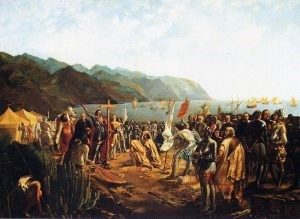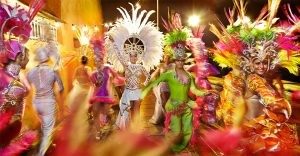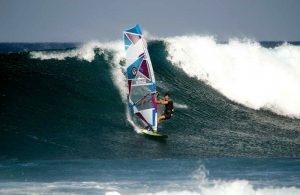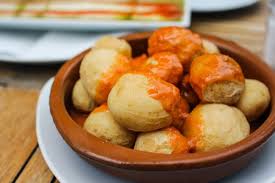CANARIAS CLIMATE, HISTORY, AND CULTURE
CLIMATE
The climate of the Canary Islands is remarkably mild. Daily average temperatures tend to vary between 18°C (64°F) and 24°C (75°F) depending on the season, although the easternmost islands (Fuerteventura and Lanzarote) are typically slightly warmer than the westernmost islands (El Hierro and La Palma). The most dramatic variations in weather actually occur on different parts of the same islands, as evidenced in this graphic of precipitation. The northern side of each island tends to be cloudier and rainier, while the southern sides are sunnier and more arid. Higher elevations also tend to receive more rain (especially in the laurisilvas, or subtropical rainforests), and the peak of El Teide is high enough to get a covering of snow and ice each winter! Weather on Fuerteventura and Lanzarote is less variable, as they are the oldest and thus most eroded of the islands, so the effects of elevation are minimal. However, wind will likely be a constant!
Rainfall follows a Mediterranean calendar, with the winter months receiving the majority of rain and the summer months receiving almost none, though this again depends on location. Most of your days will be warm and sunny, but you should be prepared for occasional winds, fog, and rain. Most canarios are extreme frioleros (people who get cold easily), which may seem funny at first, but you may find yourself losing your cold tolerance quickly and complaining with them when the temperature drops below 70°F! This is also because houses generally don’t have central heating and don’t keep in the heat well (they are designed to stay cool in the summer), so you might notice being colder inside that outside!
Although you may think you won’t need to, you should pack a couple of sweaters and a supply of long pants. Many 2021-2022 grantees recommended bringing a reliable winter jacket, clothing to layer, and more clothing for cold weather than you might’ve originally thought you needed. Some also recommended bringing a raincoat and hiking boots. Many grantees in the past have recommended bringing more warm clothes than you might initially think you need – depending on where you live or visit, you might experience winter temperatures similar to what you’ve seen in the U.S. Additionally, remember that if you plan on exploring the islands, you may stumble into some cold temperatures up in the mountains and laurisilvas.
A unique aspect of the Canarian climate is the phenomenon known as calima, during which dust-heavy winds from the African continent and Sahara Desert pass through the Islands. Due to their proximity, the eastern islands experience calima more regularly, but it comes and goes throughout the islands year round. You’ll notice that the air looks hazier, and you might find a thin coating of dust on everything. Some people experience allergy-like symptoms, and those with asthma tend to be more sensitive to calima. Winds may also pick up, and occasionally flights may be delayed or cancelled until visibility improves. Thankfully, calima does not stay for long, and will typically clear up within a few days. You can track the calima forecast using this excellent model. Though it may not be ideal, you’ll find it’s one of many things you can bond over with your co-workers and island peers!
HISTORY
 The Canary Islands were originally inhabited by indigenous peoples collectively known as the Guanches, although this term technically refers only to natives of Tenerife. The first groups are thought to have settled in the Islands as early as 100 AD. Their origin is still an active area of research, but the general consensus is that the majority have origins in the Berbers of North Africa. A recent genetic study by Fregel et al. (2019) can be found here.
The Canary Islands were originally inhabited by indigenous peoples collectively known as the Guanches, although this term technically refers only to natives of Tenerife. The first groups are thought to have settled in the Islands as early as 100 AD. Their origin is still an active area of research, but the general consensus is that the majority have origins in the Berbers of North Africa. A recent genetic study by Fregel et al. (2019) can be found here.
Colonization attempts by Castilians began in the 13th century, decimating the native population through battles and the slave trade. Though this largely eradicated the language and culture of the Guanches, a number of cultural traditions have survived in the Canary Islands. A fascinating example is silbo gomero, a loud, whistled language used in La Gomera to communicate across the island’s valleys and ravines. Originally developed for the Guanche language, today silbo mimics the rhythm and cadence of Spanish, and is preserved and taught in schools around La Gomera.
After nearly a century of colonization attempts, the Kingdom of Castile achieved complete control by 1495. After the conquest, the islands became wealthy exporting sugar cane and wine while serving as a final stopover for European ships about to cross the Atlantic headed to the Americas.
Much of the Spanish colonization of the Caribbean and Latin America was carried out by settlers from the Canary Islands and mainland Spaniards from Andalucía, which explains the linguistic and tonal similarities shared among many Latin American and Caribbean dialects of Spanish, Andalusian Spanish, and Canarian Spanish. During the 17th-19th centuries, a large number of canarios emigrated to the Americas for economic opportunities, settling in areas such as Havana, Veracruz, and St. Bernard’s Parish, Louisiana. A little-known fact is that the city of San Antonio, Texas was actually founded by canarios!
In 1927, a fierce rivalry between Las Palmas de Gran Canaria and Santa Cruz de Tenerife led to the Islands being split into two provinces: Las Palmas and Santa Cruz de Tenerife. Following the death of Francisco Franco and Spain’s transition to democracy in the late 1970s, the Canary Islands became a comunidad autónoma of Spain under the new Constitution in 1982.
Click here to read more about the cultural artifacts left behind by the native peoples of the Canary Islands.
For more information about the general history of the Islands, click here.
CULTURE
The Canary Islands offer an interesting blend of Spanish, Latin American, and particular canario traditions that make this comunidad autónoma unique. You will learn to love the Islands’ laid-back culture and relaxed attitude, even if it clashes with what we Americans are used to back in the States.
 Carnaval is the most famous celebration in Canarias and a good place to start when thinking about canario culture. Celebrated between January and March (depending on the year), Carnaval marks the beginning of Lent, and canarios celebrate this holiday a lo grande. Dressed in elaborate themed costumes, people take to the streets and watch as murgas and comparsas perform songs and routines. The celebration ends with the ceremonial burial of a sardine. While the Carnaval in Santa Cruz de Tenerife is the most famous, and is known as the second largest Carnaval celebration in the world, all seven Canary Islands have their own distinct traditions for celebrating this lively holiday.
Carnaval is the most famous celebration in Canarias and a good place to start when thinking about canario culture. Celebrated between January and March (depending on the year), Carnaval marks the beginning of Lent, and canarios celebrate this holiday a lo grande. Dressed in elaborate themed costumes, people take to the streets and watch as murgas and comparsas perform songs and routines. The celebration ends with the ceremonial burial of a sardine. While the Carnaval in Santa Cruz de Tenerife is the most famous, and is known as the second largest Carnaval celebration in the world, all seven Canary Islands have their own distinct traditions for celebrating this lively holiday.
 Given the Islands’ location and sunny climate, outdoor activities are a major part of life in Canarias. Swimming, surfing, sailing, and scuba diving are all popular activities, as well as hiking, running, and lucha canaria, or Canarian wrestling, for those looking to stay on land. Canarias is also home to a unique type of habitat known as a laurisilva, which is a sub-tropical laurel forest. Walking or driving among the curved branches and lush green is like stepping into a fantasy movie–it’s an experience you can’t miss! Laurisilvas can be found on the islands starting from Gran Canaria and moving west, exclusively at higher elevations.
Given the Islands’ location and sunny climate, outdoor activities are a major part of life in Canarias. Swimming, surfing, sailing, and scuba diving are all popular activities, as well as hiking, running, and lucha canaria, or Canarian wrestling, for those looking to stay on land. Canarias is also home to a unique type of habitat known as a laurisilva, which is a sub-tropical laurel forest. Walking or driving among the curved branches and lush green is like stepping into a fantasy movie–it’s an experience you can’t miss! Laurisilvas can be found on the islands starting from Gran Canaria and moving west, exclusively at higher elevations.
The potential for outdoor recreation is a large part of what brings many tourists to Canarias each year. You’ll find that Canarias is generally a very multicultural place, as many visitors fall in love and decide to stay. Many families also come from the Caribbean and Latin America, returning to the islands from which their ancestors once emigrated. This translates to a unique blend of businesses, foods, and cultures within each community.
 In terms of cuisine, one of the islands’ most famous dishes is papas arrugadas con mojo, which are small, salt-wrinkled boiled potatoes served with a spicy red pepper or mild green cilantro sauce. Another typical dish is puchero canario, a stew similar to cocido. Gofio is a flour-like Canarian staple made from toasted grains, put in everything from coffee to soup to dessert mousse. Fresh fish and fruits and vegetables are easy to find as well, and round out the balanced canario diet. You will never be far from a flavorful plátano canario! Island specialties include wines from the volcanic fields of Lanzarote, goat cheese from Fuerteventura, and palm honey from La Gomera. In addition to local wines, ron miel, or honeyed rum, is a popular drink in Canarias along with the local brand Arehucas.
In terms of cuisine, one of the islands’ most famous dishes is papas arrugadas con mojo, which are small, salt-wrinkled boiled potatoes served with a spicy red pepper or mild green cilantro sauce. Another typical dish is puchero canario, a stew similar to cocido. Gofio is a flour-like Canarian staple made from toasted grains, put in everything from coffee to soup to dessert mousse. Fresh fish and fruits and vegetables are easy to find as well, and round out the balanced canario diet. You will never be far from a flavorful plátano canario! Island specialties include wines from the volcanic fields of Lanzarote, goat cheese from Fuerteventura, and palm honey from La Gomera. In addition to local wines, ron miel, or honeyed rum, is a popular drink in Canarias along with the local brand Arehucas.
You will also find many influences from other cultures within Canarian cuisine, reflecting the diverse blend of people living in the Islands today, as well as the strong historical connection with the Caribbean and Latin America. For example, arepa restaurants can be found throughout the Islands, and ropa vieja (shredded stewed meat) is a common dish. You may even find speciality stores stocked with foreign products established to accommodate demands from various cultures. Living in Canarias, you will have an interesting and enjoyable culinary experience!
Check out the Canarias Ocio page as well as this website for more information about cultural programming and activities in Canarias.
LANGUAGE
While Canarias does not technically have its own co-official language (i.e. gallego in Galicia), you may hear your colleagues and island friends say something along the lines of “No hablamos español, hablamos CANARIO!” Canarian Spanish is probably unlike the Spanish you are used to hearing. It is very different from peninsular Spanish: the use of vosotros is uncommon, there is no ceceo (lisp), and many vocabulary words differ (for example, autobus = guagua in Canarias). Indeed, much of Canarian Spanish has strong connections to Latin American and Caribbean Spanish, due to the (still ongoing!) migrations back and forth across the Atlantic. Another key part of the Canarian accent is the swallowing of the letter S, mainly at the end of words. Gracias becomes “gracia”, vamos sounds more like “vamo”, and so on. You will find your accent changing to match this!
Of course, there are many island-specific idiosyncracies (it’s said that El Hierro has the clearest accent, but you will all have to visit to see if you agree!) and the accent will vary slightly island-to-island along with the vocabulary and slang. For example, depending on the island, “popcorn” may be called palomitas, roscas, or cotufa. You’ll pick up your island’s terms quickly by listening to your co-workers, and will find it’s very fun to compare notes with other Fulbrighters! One thing you’re sure to hear quite often no matter where you live is “¡¡¡CHACHO!!!”, which is short for muchacho (and can also be chacha!) and is a multi-use tool for addressing people and for expressing surprise, frustration, and more.
You may find it difficult at first to adjust to the Canarian way of speaking, but do not fret – the people around you will be patient and you’ll be “fluent” in canario before you know it!
Due to the culturally diverse nature of inhabitants on the islands, in one classroom you may have students from Spain, Germany, Morocco, England, Russia, Italy, Venezuela, Cuba, and more! Because of this, you may have multilingual language learners in your classroom. It is not uncommon to teach students whose first language is not Spanish or English, but perhaps instead Arabic, Russian, or German. This is an important dynamic to keep in mind when planning English lessons.